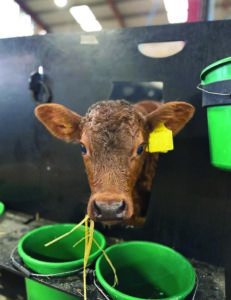The effects of heat stress and warm weather in calves are not as well documented and can often be overlooked compared to their dairy cow counterpart, due to having no obvious production loss. Although calves have an upper critical limit of 25ºC, they can start to feel the effects of heat stress at 21ºC. Above 20ºC the calf will use additional energy to maintain a normal body temperature, shifting vital energy away from growth. Similar to when it’s cold, calves require more energy to keep warm. When it is hot, calves require energy to keep cool.
MILK FEED
Prolonged exposure to temperatures above 20ºC can lead to a significant drop in daily live weight gain. A calf uses an extra 20-30% more energy to keep cool, so feeding more milk or milk replacer during hot weather is essential to maintain growth rates and a healthy immune system. It is suggested that for every 5ºC increase above 20ºC, calves should be given an extra 1.5-2 litres of CMR or milk.
WATER
Calves should have access to clean water from day 1 as it is a vital nutrient and critical to both daily liveweight gain and rehydration. Also, during warm weather, water is critical to allow the calf to keep cool. Heat is transported out of the body during urination, the more water the calf can drink the better they can manage their temperature. Never underestimate the importance of easy access to fresh water!
STARTER INTAKE
A calf suffering from heat stress is much more likely to have reduced starter feed intakes, so ensure feed is fresh to encourage intakes. This also highlights the importance of the milk feed, to bridge this gap. However, this increase in milk or milk replacer can make the weaning process more difficult.
VENTILATION
Air flow and movement help keep calves cool. For sheds with poor ventilation, where it is impractical to change the shed design, adding fans to pull air through the shed can help. The fans should be used to move the air above the calves and to remove stale air, but not to create a draft at ground level. Reducing stocking density is another element that can help calf comfort during high temperature periods; the more space a calf has away from others the easier it will be for them to regulate their body temperature.
REHYDRATION AND HYDRATION
Where temperatures are high and calves could be at risk of dehydration, regularly offering calves an electrolyte feed in the middle of the day can be beneficial. A calf has twice the amount of extracellular fluid (fluid outside of cells) compared with an adult cow, and dehydration is caused when this fluid is lost and why we can see signs such as sunken eyes. Sodium is an important element needed to restore this lost extracellular fluid, whereas potassium is a key nutrient for cow rehydration (to replenish their intracellular fluids – the fluid inside of cells).
Electrolytes should contain between 10-30mM/L of potassium and between 40-80mM/L of chloride, generally, most products on the market will contain these, the key ingredient is glycine (acetate or glucose) to help with sodium absorption. Glycine can be expensive so is not always included, but as a transport aid, it must be included to allow sodium absorption, it is essential in correcting water deficit. Look at the electrolyte, ask the questions and make sure it is fit for purpose!
MANAGEMENT
Any handling such as weighing, and vaccinating should be done early in the morning whilst temperatures are at their lowest to avoid stressing the calves later in the day when temperatures are higher.
For more information on our Youngstock Services, please speak to your NWF Sales Specialist, or get in touch with our Youngstock Team.

